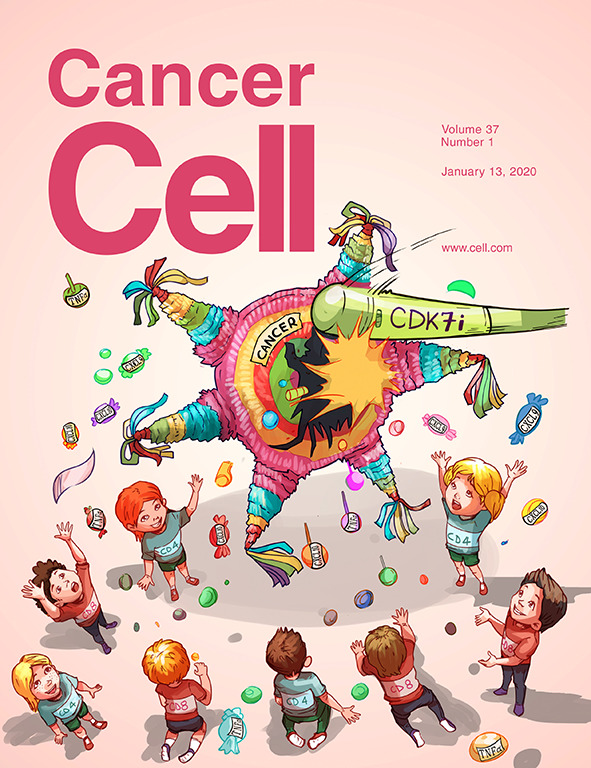TIM3+ breast cancer cells license immune evasion during micrometastasis outbreak
IF 44.5
1区 医学
Q1 CELL BIOLOGY
引用次数: 0
Abstract
In metastasis, the dynamics of tumor-immune interactions during micrometastasis remain unclear. Identifying the vulnerabilities of micrometastases before outbreaking into macrometastases can reveal therapeutic opportunities for metastasis. Here, we report a function of T cell immunoglobulin and mucin domain 3 (TIM3) in tumor cells during micrometastasis using breast cancer (BC) metastasis mouse models. TIM3 is highly upregulated in micrometastases, promoting survival, stemness, and immune escape. TIM3+ tumor cells are specifically selected during early seeding of micrometastasis. Mechanistically, TIM3 increases β-catenin/interleukin-1β (IL-1β) signaling, leading to stemness and immune-evasion by inducing immunosuppressive γδ T cells and reducing CD8 T cells during micrometastasis. Clinical data confirm increased TIM3+ tumor cells in BC metastasis and TIM3+ tumor cells as a biomarker of poor outcome in BC patients. (Neo)adjuvant TIM3 blockade reduces the metastatic seeding and incidence in preclinical models. These findings unveil a specific mechanism of micrometastasis immune-evasion and the potential use of TIM3 blockade for subclinical metastasis.

TIM3+乳腺癌细胞在微转移爆发时允许免疫逃避
在转移中,微转移过程中肿瘤免疫相互作用的动力学尚不清楚。在微转移爆发为大转移之前识别其脆弱性可以揭示转移的治疗机会。在这里,我们报道了T细胞免疫球蛋白和粘蛋白结构域3 (TIM3)在乳腺癌(BC)转移小鼠模型中微转移过程中在肿瘤细胞中的功能。TIM3在微转移中高度上调,促进存活、干性和免疫逃逸。TIM3+肿瘤细胞是在微转移的早期播种阶段特异性选择的。机制上,TIM3增加β-catenin/interleukin-1β (IL-1β)信号,在微转移过程中通过诱导免疫抑制性γδ T细胞和减少CD8 T细胞导致干细胞和免疫逃避。临床数据证实,BC转移中TIM3+肿瘤细胞增多,TIM3+肿瘤细胞是BC患者预后不良的生物标志物。在临床前模型中,(Neo)佐剂TIM3阻断可减少转移的发生和发生率。这些发现揭示了微转移免疫逃避的特定机制,以及TIM3阻断在亚临床转移中的潜在应用。
本文章由计算机程序翻译,如有差异,请以英文原文为准。
求助全文
约1分钟内获得全文
求助全文
来源期刊

Cancer Cell
医学-肿瘤学
CiteScore
55.20
自引率
1.20%
发文量
179
审稿时长
4-8 weeks
期刊介绍:
Cancer Cell is a journal that focuses on promoting major advances in cancer research and oncology. The primary criteria for considering manuscripts are as follows:
Major advances: Manuscripts should provide significant advancements in answering important questions related to naturally occurring cancers.
Translational research: The journal welcomes translational research, which involves the application of basic scientific findings to human health and clinical practice.
Clinical investigations: Cancer Cell is interested in publishing clinical investigations that contribute to establishing new paradigms in the treatment, diagnosis, or prevention of cancers.
Insights into cancer biology: The journal values clinical investigations that provide important insights into cancer biology beyond what has been revealed by preclinical studies.
Mechanism-based proof-of-principle studies: Cancer Cell encourages the publication of mechanism-based proof-of-principle clinical studies, which demonstrate the feasibility of a specific therapeutic approach or diagnostic test.
 求助内容:
求助内容: 应助结果提醒方式:
应助结果提醒方式:


